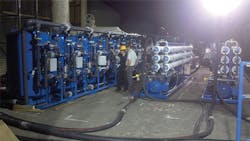Temporary Treatment
A zero liquid discharge power plant in the western United States was experiencing problems with its cold lime softening system, resulting in an inability to send cooling tower blow-down water to the evaporator. As a result, 4 million gal of untreatable water had accumulated and needed offsite disposal or onsite treatment. Cost estimates for hauling and offsite disposal of the water was approximately $1 per gal, for a total of $4 million. Watersurplus was contracted to help mitigate the problem by reducing the volume by 85%.
Process
Within two weeks of being contacted, Watersurplus mobilized a temporary water treatment plant consisting of three 125-gal-per-minute (gpm) multimedia filter tanks, three 125-gpm activated carbon filter tanks, two 150-gpm brackish reverse osmosis (RO) skids and one 75-gpm reject recovery RO skid. Watersurplus provided startup and initial operation services. Surplus brackish RO membrane elements were used in the two 150-gpm primary RO units. Surplus desalination membrane elements were used in the 75-gpm reject recovery RO unit.
Performance
After six months of operation, this mobile water treatment plant successfully reduced the volume of untreatable water by 85%, or 3.4 million gal. The remaining 600,000 gal of untreatable water was hauled away for disposal.
